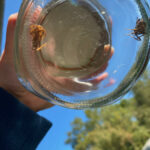Recently, a reader wrote to us about the crickets he is raising, which as of late have been dying at a fast rate. The reader speculated that his crickets are falling victim to horsehair worms, which are parasites that belong to the phylum Nematomorpha. A horsehair worm can develop in the bodies of several insects, including grasshoppers, cockroaches, and, yes, crickets. The reader’s question was twofold: are his crickets dying from horsehair worms, and is there anything he can do to eliminate the problem to save his crickets?
Let us begin by stating that it is very likely that our reader’s crickets are in fact being infected by horsehair worms. Infecting crickets, after all, is one of the central missions of horsehair worms – it’s what they do.
There are of course definitive ways to tell if the crickets are being afflicted by horsehair worms, and the main one is this: they will emerge from the insects they kill if the insects are near water, meaning you should be able to see horsehair worms emerge from whatever insects they are exploiting if they are near water. If the infected insect is not near water, the horsehair worm likely won’t emerge, but if you’re willing to dissect the insect after it dies, you’ll be able to see the worm buried inside it. Horsehair worms also exist independently of insects in water – like puddles on the sidewalk, where they are sometimes observed – and very moist soil, although the latter is somewhat rare.
If you are looking for horsehair worms, it’s helpful to know what they look like. To that end: as their name implies, horsehair worms look a lot like horse hairs, which is to say they are long and extremely thin. In fact, the horsehair worms earned their name because they were formerly believed to be the tail hair of horses that somehow morphed into living organisms. They are about as thin as the lead of a mechanical pencil and can grow to be as long as a foot, although rarely longer. They come in different colors, ranging from a creamy off-white to a blackish hue. Given the dimensions of their bodies, they are often found coiled and twisted up, rather like a discarded piece of dental floss. If you observe them when they are alive, you’ll notice them crawling or swimming about in a whip-like motion.
Unless you are raising insects for a particular purpose, horsehair worms are nothing to worry about. They don’t infect humans or pets, and they are safe to touch. (For example, if they were in your swimming pool and you didn’t want them there, you could just scoop them out with your hand, and this shouldn’t present any danger to you.) However, they do prey on insects that are commonly regarded as house pests, like cockroaches and beetles, so they are actually beneficial to have around if you are trying to limit the amount of insects in and around your house.
Since our reader is raising crickets for a reason (the specifics of which were not supplied to us), he obviously wants to keep horsehair worms from infecting his insects. Without knowing the particulars of our reader’s insect-raising operation, all we can offer are a couple of commonsensical solutions to the problem. First, make sure that your crickets aren’t being kept by any pool of water, or if for some reason they absolutely must be near some accumulation of water, make sure that there are no horsehair worms in it. They are small, but definitely visible to the naked eye.
Second, make sure that the infected crickets are removed from the other crickets, as a horsehair worm will enter another insect once it leaves one behind. Unless a huge number of crickets are infected and they can’t be removed from the group, this should solve the problem. If the infections are so widespread that most of the critics are infected, we regret to say that it may be necessary to start raising a second set of crickets that are definitively separated from the infected batch.
All About Worms is always free, always reader-supported. Your tips via CashApp, Venmo, or Paypal are appreciated! Receipts will come from ISIPP Publishing.














